Super-Boosted Healthspan Muesli – Powerful Antioxidant, Cholesterol-Reducing Nutrition
It Will Keep You Full Until Lunchtime, and Could Measurably Improve Your Health
RECIPE : Super-Boosted Healthspan Muesli
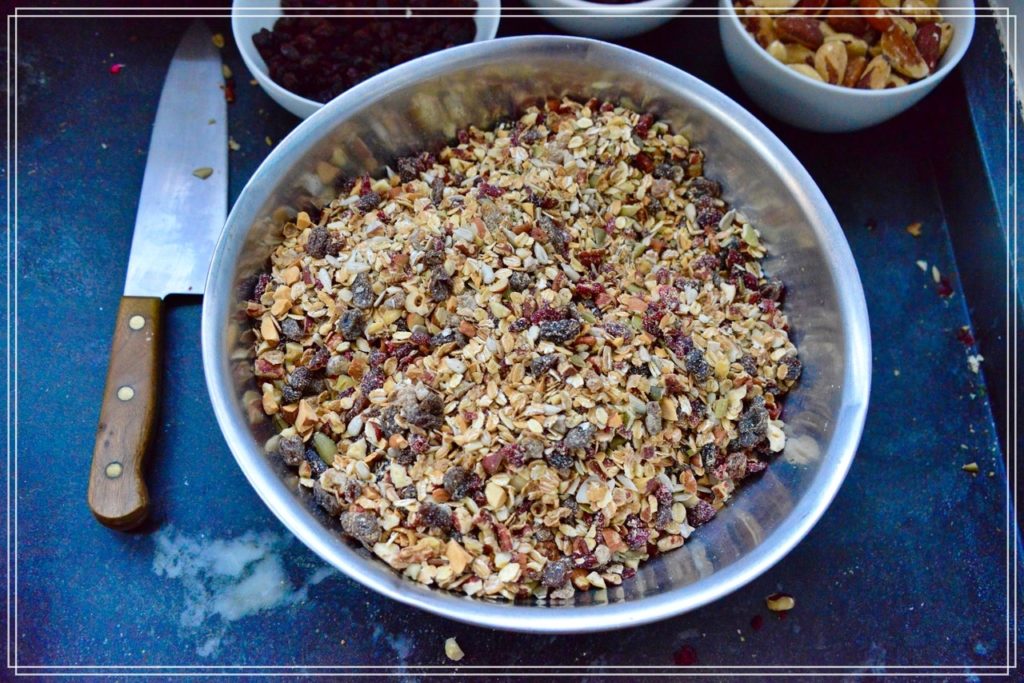
It’s often said that part of keeping weight down is to breakfast like a king, lunch like a prince and dine like a pauper. Front-loading calories in your day as opposed to skipping breakfast altogether is a well-debated question, but there is research showing the benefits to weight and metabolism of a big breakfast as long as you can limit what you eat later in the day (SEE ARTICLE: Breakfast Like a King, Lunch Like a Prince, Dine Like a Pauper.)
The only trouble with this formula is the kind of highly processed product, light on fiber and nutritional content but often drenched in sugar, widely eaten at breakfast. Not only do many breakfast cereals contain a high glucose load, but they release it rapidly into the bloodstream, triggering a spike in insulin (which stores much of the sugar as fat) and leave you hungry by the middle of the morning.
Eggs, avocados, yoghurt and other foods rich in protein and healthy fats are recommended for people who want to cut down on their intake of carbohydrates. They delay the emptying of the stomach and prolong the feeling of fullness, as well as moderating the release of insulin. But there are high quality carbohydrates that also release their energy slowly, whole grains that also provide fiber, minerals, vitamins and a range of antioxidant phytochemicals.
Oatmeal (“porridge” in the UK and elsewhere) is an outstanding example, with huge fiber content capable of reducing cholesterol at the same time as nurturing beneficial bacteria. But for a breakfast you will wake up thinking about, which will banish hunger for hours and is a treasure trove of health-giving vitamins, minerals, phytochemicals and fiber, you could barely improve on muesli. The trouble is that most shop-bought muesli contains so much sugar that it undoes much of the benefit of whole grains, nuts and dried fruit. Even the rarer, unsweetened varieties can seem a little thin, in need of embellishment to create a richer and more satisfying and nutritious mix.
Our muesli mix couldn’t be easier to make: all you need to do is chop nuts and cranberries and add them to the mix with raisins. The fat and protein in the nuts – see the table below – will slow the release of energy from the muesli. So will any milk or yoghurt you have with it. The raisins and cranberries give it a sweet as well as nutty taste.
You could buy the all the whole grain ingredients – rolled oats, barley, wheat bran, etc. – as well as the fruit and nuts separately, but a good combination exists in sugar-free Alpen and Bob’s Redmill unsweetened muesli. Nuts are available from many supermarkets, and notably from Trader Joe’s.
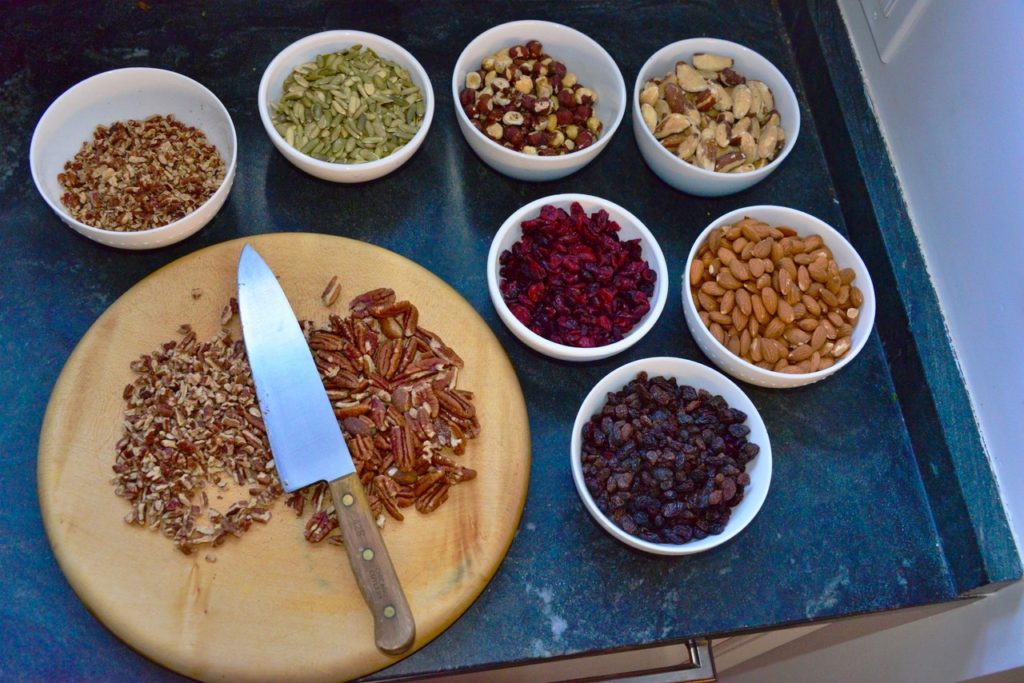
Easy as! You just chop the nuts and cranberries and mix them in.
A line in small font on the front of the pack of No Sugar Added Alpen warns “not a low calorie food”, and we have added considerably to the calories in this mixture. But you’ll see below how HealthSpan muesli represents concentrated, health-enhancing nutrition of the first order, the very opposite of the “empty”, nutrition-free, weight-inducing calories of sugary processed food.
Ingredients
Start by using two 14oz (397g) boxes of the “no sugar added” Alpen and one 40oz (1.13kg) pack of Bob’s Redmill “Old Country Style Muesli” to make up approximately half 41/4 lb of the muesli base.
The Alpen’s ingredients in descending order of weight: whole grain oats, whole grain wheat, raisons, almonds, hazelnuts. Bob’s Redmill ingredients also by weight: whole grain wheat, dates, sunflower seeds, raisins, whole grain rye, barley, whole grain oats, whole grain Triticale (a variety of wheat), almonds, flaxseed, walnuts.
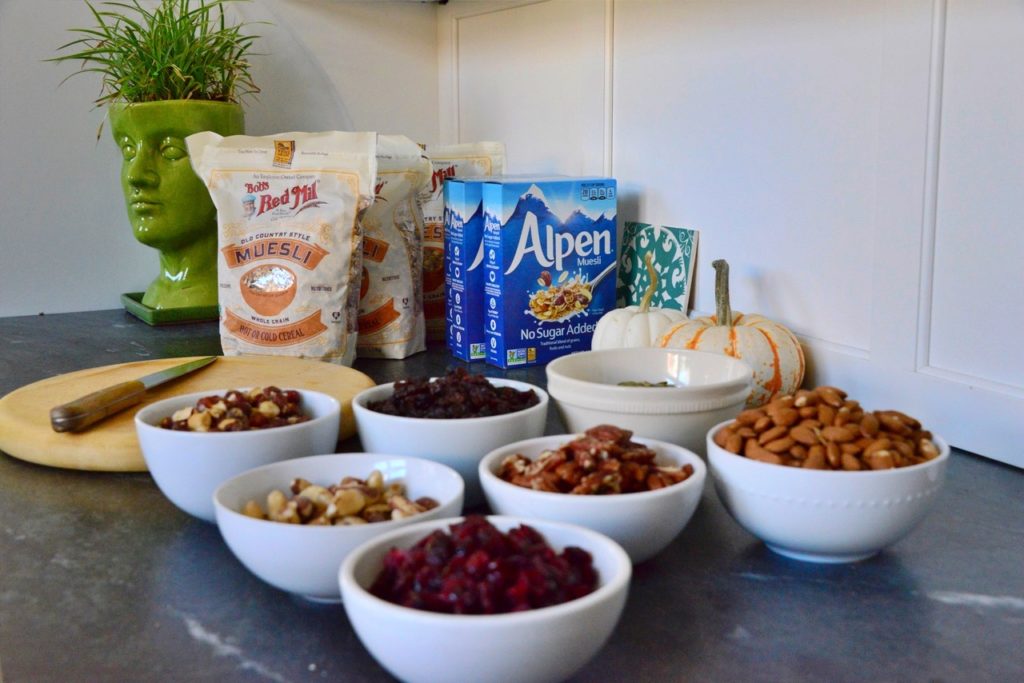
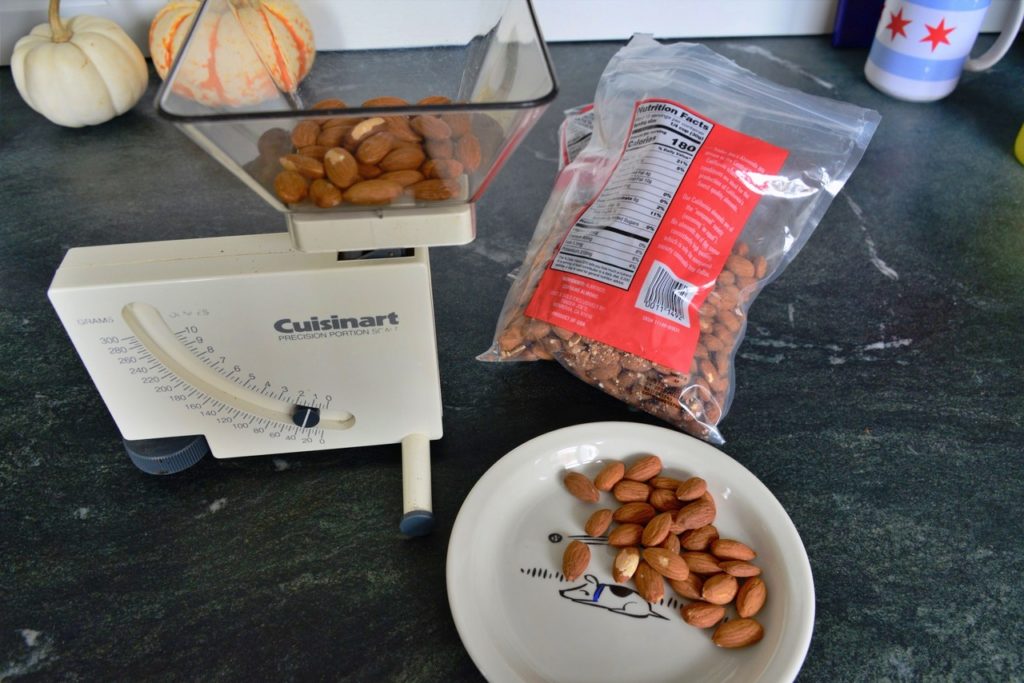
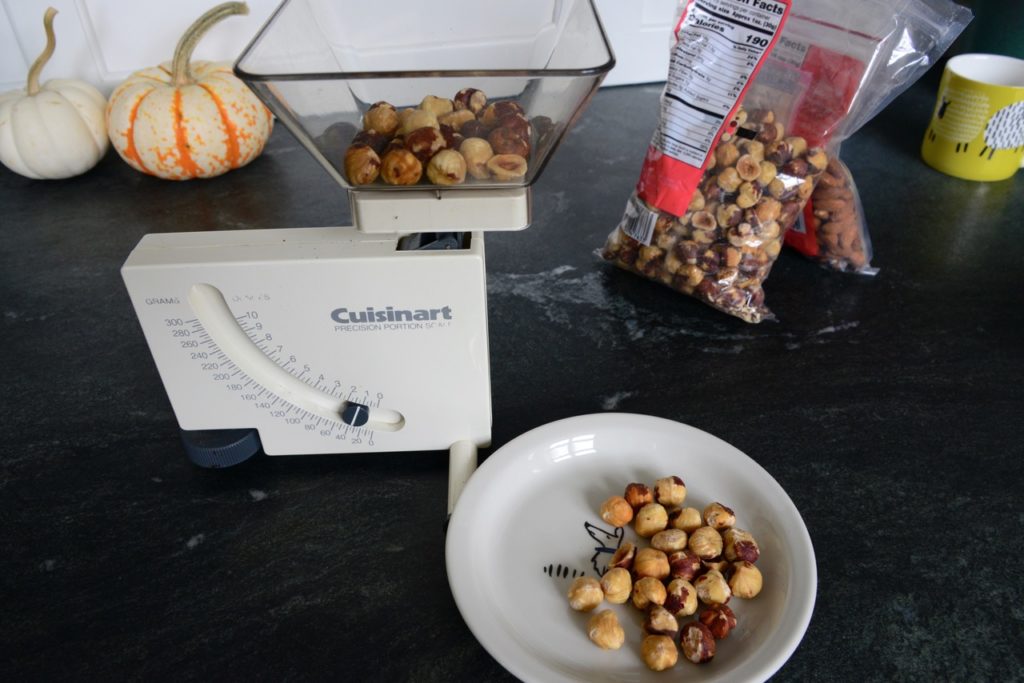
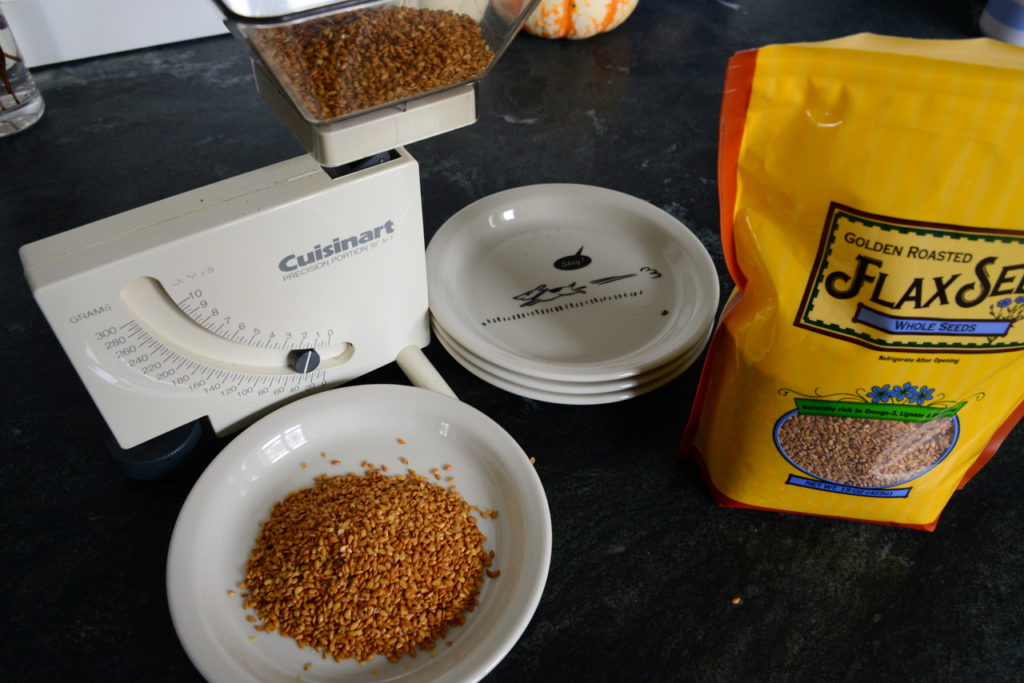
- 1 lb (454g) roasted, unsalted almonds
- 1 lb (454g) roasted, unsalted Brazil nuts
- 1 lb (454g) roasted, unsalted hazelnuts
- 8 oz dry toasted, unsalted pecan halves (don’t get pieces because chopping increases their exposure to the air)
- 8oz (227g) roasted, unsalted pumpkin seeds
- 8oz (227g) roasted, unsalted sunflower seeds
- 1 lb (454g) seedless raisins
- 8oz (227g) dried cranberries, sweetened (unsweetened if you don’t need the extra sweetness) cranberries
- Add any other grain, nut, seed or fruit you like – such as oat bran, walnuts, or dates (for added sweetness)
Serve with: ground toasted flaxseed and chia seed.
Method
1 Empty the unsweetened wholegrain muesli and mix together in a large bowl.
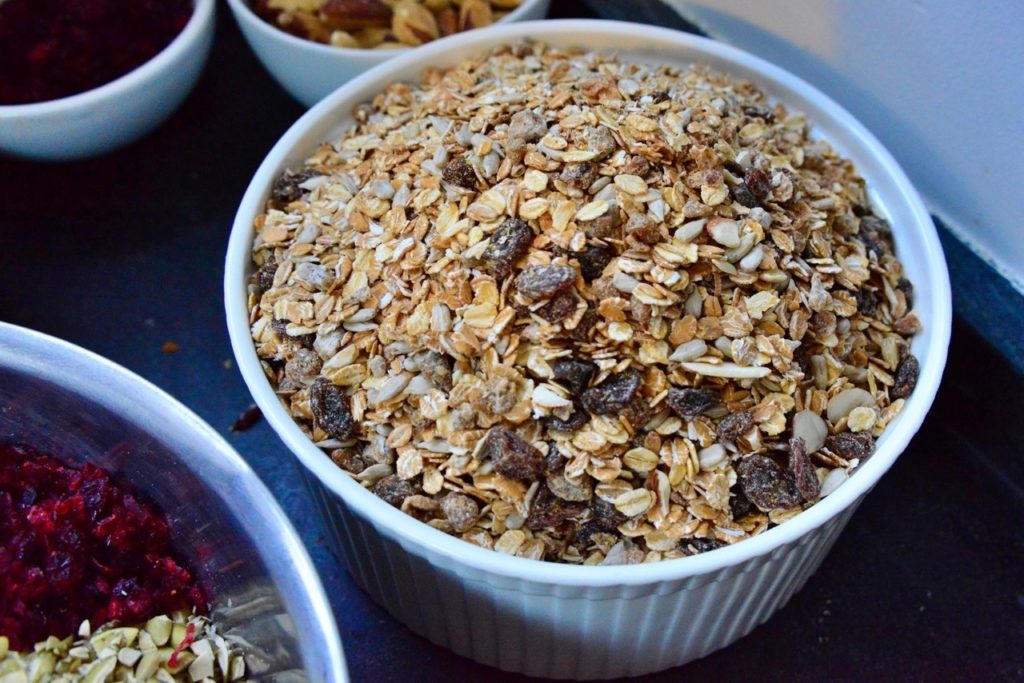
2 Chop the (sticky) cranberries and mix them into the dry muesli mix.
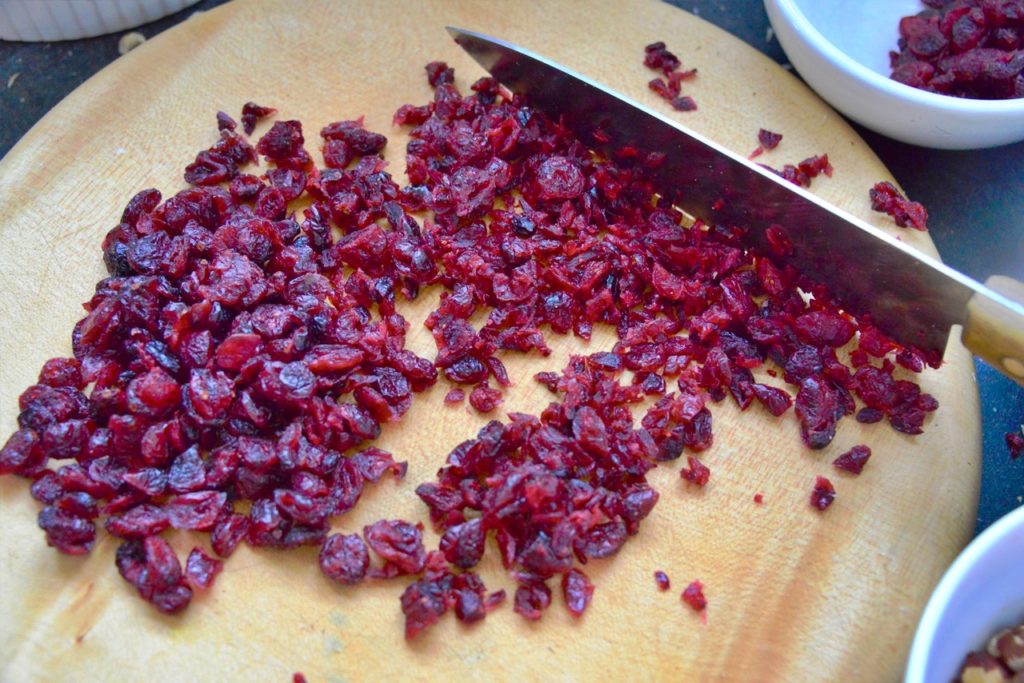
3 Add raisins and mix in. (The slightly powdery whole-grain mixture will minimize sticking of the fruit.)
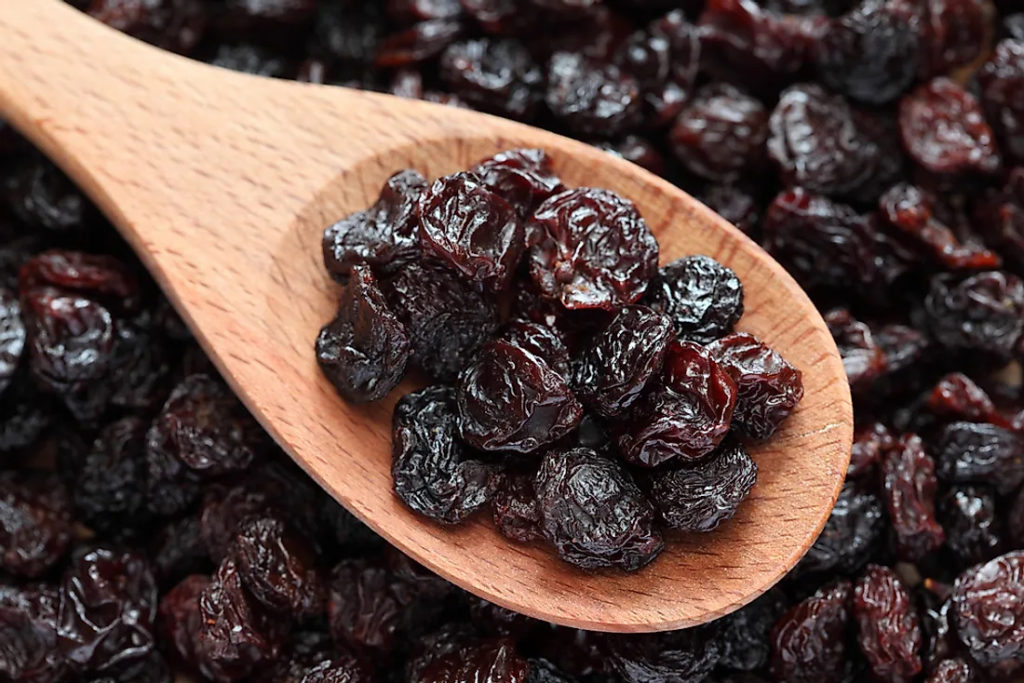
4 Chop the nuts and combine them with the mixture. Simple as!
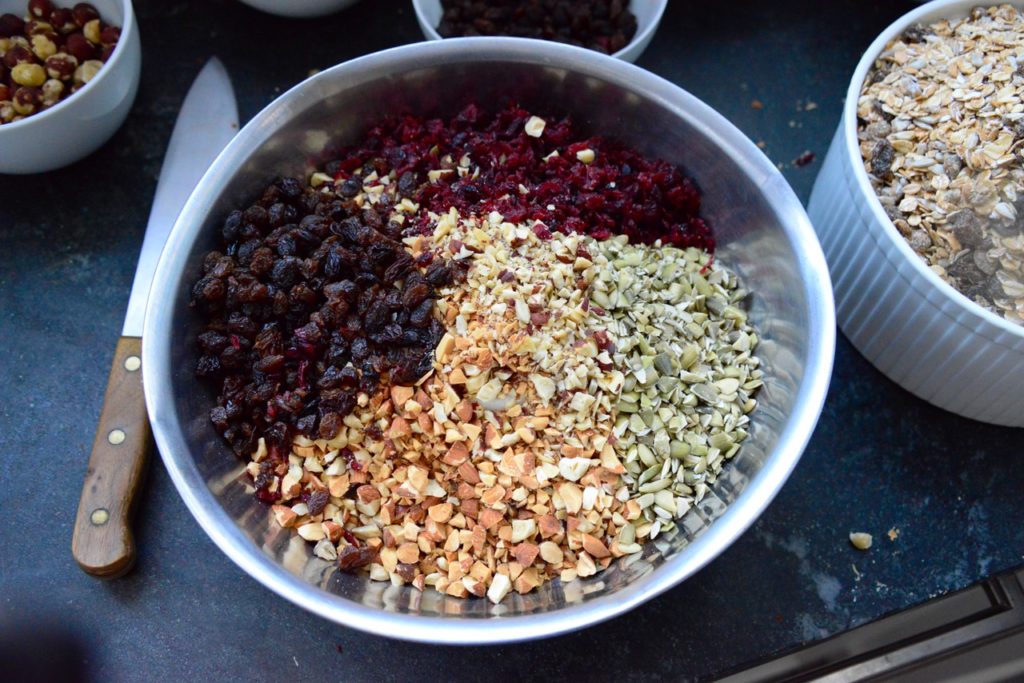
Pack the muesli into airtight containers and keep refrigerated – the best container is a resealable plastic bag out of which you can squeeze the air before fastening it. This is important because, once chopped, the polyunsaturated (mostly omega 6) fats contained in the nuts will be more vulnerable to oxidation in the air and could lose much of their beneficial quality. This is especially true of the flaxseed: it contains significant amounts of plant-based omega 3 polyunsaturated fat which is particularly susceptible to oxidation. After the seeds are ground and lose their tough protective husk their powdery contents present a far greater surface area to the air.
What’s in it for my body?
Nuts and seeds work protect against the most common chronic diseases
Usually, there are a couple of key ingredients in our recipes that are particularly beneficial for our bodies, but the secret of HealthSpan muesli is the collective impact of all its constituents. Scientific studies show that each of them separately has potential or actual beneficial effect on us. However, nuts and seeds – which make up most of the ingredients added to the sugar-free muesli bases – also share many characteristics that protect against chronic diseases such as diabetes, hypertension and cardiovascular disease. Nuts and seeds have been shown to reduce some of the most important causes of these diseases oxidation damage to cells, inflammation, resistance to insulin, dysfunction in blood vessels and the most damaging kinds of obesity.
Nuts vary in their contents and therefore in their effect on the body, but they are generally a rich source of protein, unsaturated fats, cholesterol-reducing phytosterols, the antioxidant vitamin E, and L-arginine, an amino acid thought to benefit arteries and the flow of blood. As a result, eating nuts has been associated with a reduction in the ratio of harmful low-density lipoprotein cholesterol (LDL) to beneficial high-density lipoprotein cholesterol (HDL), a lowered risk of inflammation and blood clots, and a dampening of appetite leading to lower consumption of unhealthy alternatives.
Part of the reduction in appetite is the result of nuts’ protein content. (Their fat and fiber also has this effect.) Relative to other plants, the protein content of nuts is high, but they are notably limited in some of the essential amino acids (ones our bodies can’t make) including lysine and methionine. To make up for that shortfall among plant sources, lysine is available in almost all beans and in oats. Brazil nuts contain methionine, as do oats, some seeds such as hemp and sesame, and beans. Meat, poultry, fish, dairy products and eggs, and a small number of plants – such as soy beans, quinoa and buckwheat – are “complete protein” sources, containing all nine of the essential amino acids.
Almonds – improve sensitivity to insulin, lower blood pressure, even reduce weight
Among the nuts in our Chicago muesli there’s ample evidence from scientific studies for the benefits of almonds. Eighty percent of almonds are currently grown in California, but they’ve been grown from ancient times: evidence has been found for their cultivation in Jordan 5,000 years ago.
Almonds’ beneficial effects on health include a lowering of insulin in the blood and of insulin resistance (in which cells stop responding to the command of insulin to allow glucose in). They also appear to limit the damaging oxidation of fats and to decrease harmful LDL cholesterol while maintaining beneficial HDL.
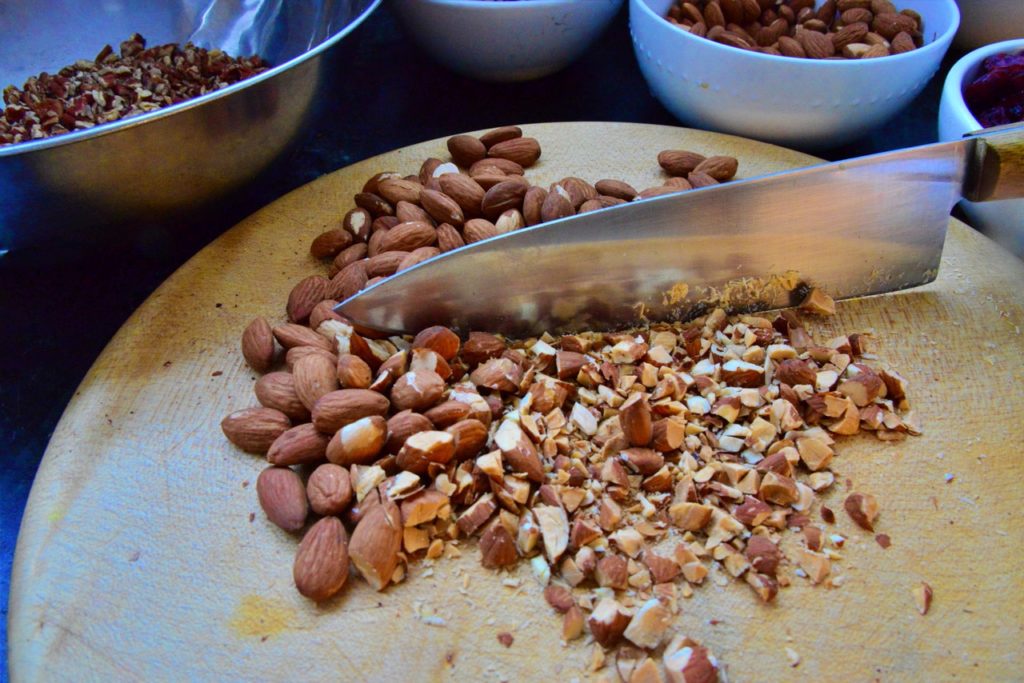
Almonds are calorific, but studies find they promote weight loss.
A study in which young and middle-aged men whose diets were supplemented with 50g of almonds a day for four weeks recorded a significant increase in the antioxidant vitamin E in their blood, and improved flow in blood vessels. Even over this short period systolic pressure (the higher number – around 120 – recording pressure from the heart pumping blood out to the body) was significantly reduced, as was diastolic pressure (the pressure from blood vessels squeezing blood back to the heart) in healthy men.
Virtually the only disadvantage of almonds – like other nuts – is that they are relatively calorific, but it’s there is more to even this potential problem than is immediately obvious. Studies have shown that the ability of almonds to dampen appetite allows people to consume sizable amounts without putting on weight. It seems that apart from inhibiting consumption of less healthy alternatives, the nutritional composition of almonds – including their high fiber content – causes them to give up their energy inefficiently.
Indeed, supplementing diets with almonds has been shown to decrease the harmful abdominal fat stores of participants even though their overall weight remained unchanged.
Hazelnuts –a rich source of manganese
Hazelnuts – also known as filberts (US) and cobnuts (UK) – contain significant amounts of several essential nutrients, such as iron, phosphorus, magnesium, and, vitamin B1, known as thiamin. They are particularly rich in the mineral manganese – which plays a central role in the conversion of food into energy and allows the powerful antioxidant superoxide dismutase to function. A small 30g handful provides 88% of the daily adult requirement of manganese and 30% of the requirement for another important antioxidant vitamin E.
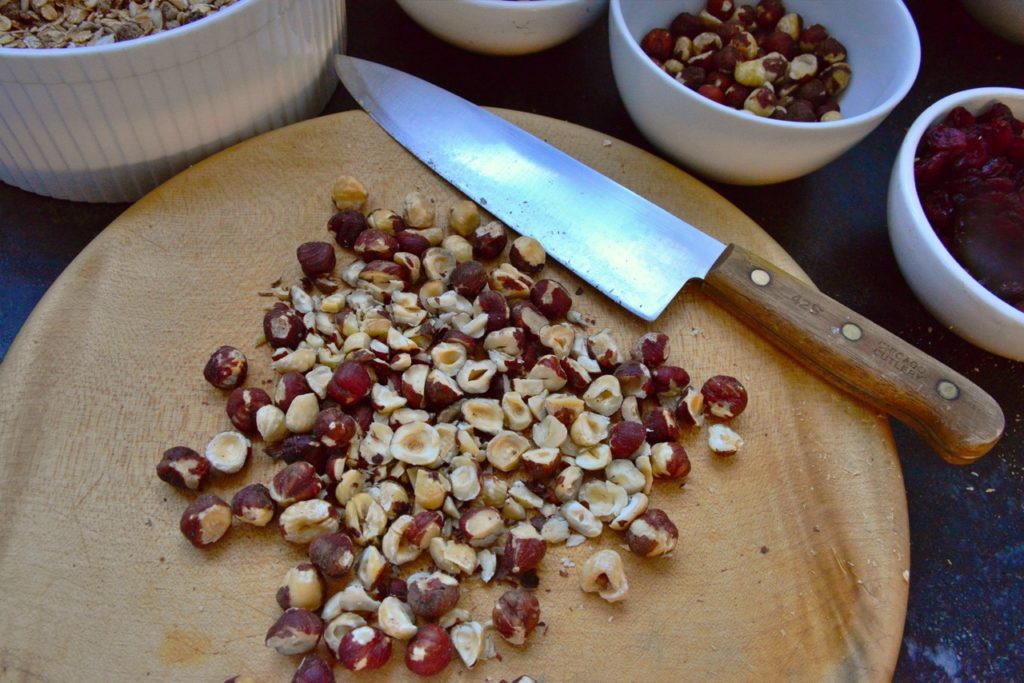
The healthy fats in Hazelnuts reduce harmful cholesterol.
The largely monounsaturated (as in olive oil and avocados) and polyunsaturated (as in many vegetable oils) fats in hazelnuts appear from a review of nutritional studies significantly to reduce levels of total cholesterol and harmful LDL cholesterol while leaving the beneficial HDL cholesterol as well as weight unaffected. A study on children with excessive fat levels in their blood found a similar effect on their levels of cholesterol.
A substantial cause of cardiovascular disease – the formation of plaques in arteries – is the oxidation of LDL cholesterol and the activation of the immune system (inflammation) that results from it. The fact that hazelnuts also appear to reduce the risk of cardiovascular disease might be the result of their fiber content, and that of phytochemicals such as gallic acid, p-hydroxy benzoic acid, epicatchin and quercetin.
Pecans – huge antioxidant content reduces damaging oxidation of LDL
Although pecans – like hazelnuts – would justify their place in any muesli mix because of their distinctive rich taste, they are also an extremely rich source of the antioxidants we need to neutralize free radicals. Free radicals are highly reactive and unstable molecules with unpaired electrons and the ability to damage other important molecules in the cell including DNA by donating an unwanted electron or seizing one from them. Antioxidants are able to stabilize these toxic molecules by donating electrons to them without themselves becoming free radicals.
One leading way of measuring the antioxidant content of food, known as Ferric Reducing Ability of Plasma (FRAP), records pecans as containing up to 10.6 mmol of antioxidants per 100g (about 3.5oz), more than the 9.2 mmol of the highly antioxidant fruit, blueberries. For more detail about free radicals and antioxidant food see article “Oxidation Is Aging Us and Causing Disease. Antioxidants in Foods Can Neutralize the Free Radicals Causing It”.
Scientific studies have borne out the antioxidant power of pecans, and represent convincing evidence for how eating certain foods can directly affect a cause of disease. For example, one study found a rapid effect of eating pecans on the levels of oxidised LDL cholesterol, which is a leading risk factor for cardiovascular disease. A (fairly small) number of people were fed pecans or an alternative of the same number of calories, and shown to have absorbed significant amounts of their antioxidants into their blood, with the result that level of oxidised LDL in it had fallen by between a quarter and a third.
Other studies confirm the beneficial effect of pecan nuts on LDL cholesterol levels, both in healthy people and those with normal to high cholesterol levels.
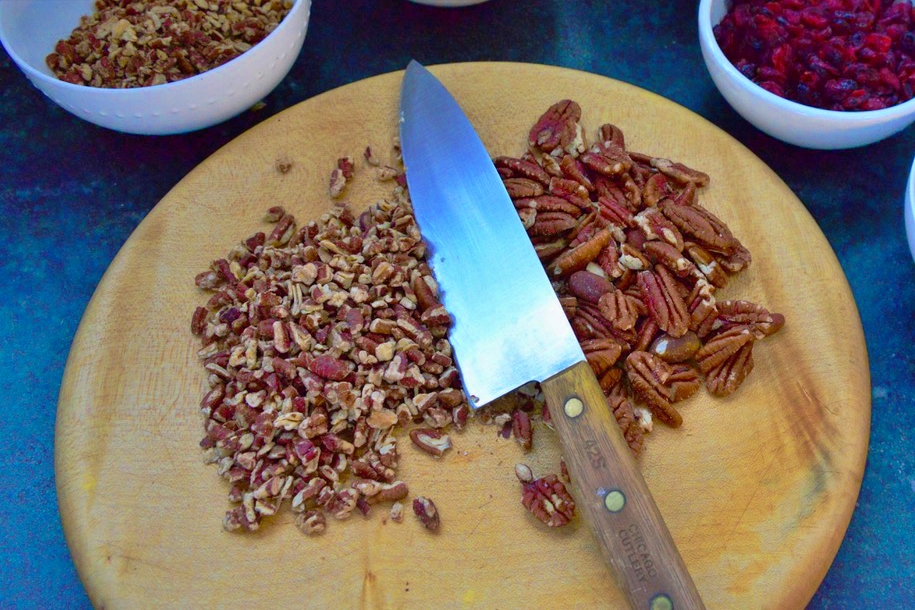
By some measures, pecans contain more antioxidant power than blueberries.
A four-week pecan-rich diet was found by researchers at Tufts University to reduce the risk of another disease, diabetes, as well as cardiovascular disease. It suggested that the consumption of pecans had reduced resistance to insulin and the amount of the insulin left in the blood, as well as improving the functioning of the pancreatic cells producing the hormone.
The pecans, almonds, Brazil nuts, and hazelnuts in a single serving of our Chicago muesli are limited (especially in comparison to the doses used in some of these studies), but given that nuts and seeds have broadly similar effects on disease risk factors it’s their collective effect that’s important. For example, 1oz (about 30g) handful of hazelnuts provides 30% of an adult’s daily requirement for vitamin E, but ounce for ounce another constituent of the muesli, Sunflower seeds, are an even richer source.
Brazil nuts – one nut a day keeps the doctor away!
Brazil nut are among the tallest species in tropical rainforest and one of the longest lived, with a lifespan of around 500-700 years. As a food, their outstanding quality is an extraordinarily high content of the mineral selenium. Selenium is an antioxidant by virtue of the part it plays in neutralizing damaging free radicals which originate in environmental pollution, certain foods, solar radiation, our immune systems and as the automatic byproduct of metabolizing food for energy. (See article “Oxidation Is Aging Us and Causing Disease. Antioxidants in Foods Can Neutralize the Free Radicals Causing It”.)
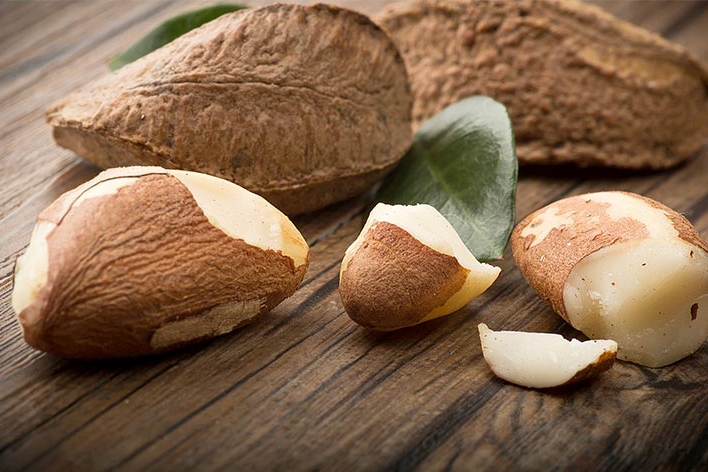
Brazil nuts contain huge amounts of selenium, a vital antioxidant mineral.
Selenium is essential for the operation of a vital family of antioxidant enzymes called glutathione peroxidase, and Brazil nuts contain an extraordinary amount of it. Remarkably a single Brazil nut contains between 68 and 91micrograms of selenium, more than the daily recommended allowance for an adult of 55mcg, and a dose of one a day has been shown to increase the activity of glutathione peroxidase, and to have measurable improvements in various aspects of health. These include a decrease in DNA damage in obese women, a reduction in inflammation and oxidative stress in patients with chronic kidney disease, and lower total cholesterol and amounts of glucose in the blood in healthy adults.
There appears to be a clear link between consumption of Brazil nuts, levels of oxidation, and another potentially damaging process, inflammation (the activation of the immune system that can be caused by oxidative stress). One study suggested for example that a single serving, amounting to either 4 or 10 Brazil nuts, could significantly reduce two critical markers of inflammation, the cytokines interleukin-6, and tumor necrosis factor alpha, the latter of which is capable of causing fever.
Brazil nuts contain other antioxidants as well as selenium, including vitamin E and manganese, which is an important element (“cofactor”) in the functioning of another critical antioxidant enzyme, superoxide dismutase. The nuts also contain phytochemicals such as the phenols gallic acid and ellagic acid (more about these another time). But you have to consume them routinely to get the benefit of their nutrients, including selenium, so it makes sense to incorporate nuts such as these into something like muesli that you will eat regularly.
Pumpkin seeds – their effect on hormones can curb excess growth of prostate
Pumpkin seeds have been designated as the best source of zinc and magnesium by the World Health Organization. A tablespoon of the seeds contains almost a fifth of the recommended daily intake (almost 1mg of zinc and 40mg of magnesium). They’re also rich in manganese, copper, iron, phosphorus and potassium – with a range of important functions in the body. The advantages are such that the American Heart Association recommends that adults eat 30g (a quarter cup) a day of pumpkin seeds.
There’s evidence that, like the other nuts and seeds in our enhanced muesli, they protect against cardiovascular disease.
Pumpkin seeds are particularly recommended for men with benign prostatic hyperplasia, the age-related, non-cancerous, enlargement of the prostate gland that affects half of men aged between 51 and 60, and increases in prevalence in older age groups. A pumpkin seed extract was found to reduce symptoms of enlarged prostate (frequent urination and retention of urine in the bladder).
It’s thought excessive growth (hyperplasia) in the prostate could be caused partly by an imbalance between estrogen and testosterone. This change is accompanied by overproduction of an enzyme called 5-alpha reductase which promotes prostatic hyperplasia. However, 5-alpha reductase has been shown in laboratory experiments to be inhibited by an extract of pumpkin seed oil. These oil-free extracts are several steps removed from the pumpkin seeds in muesli, but these studies add to the evidence for the biological activity of its ingredients.
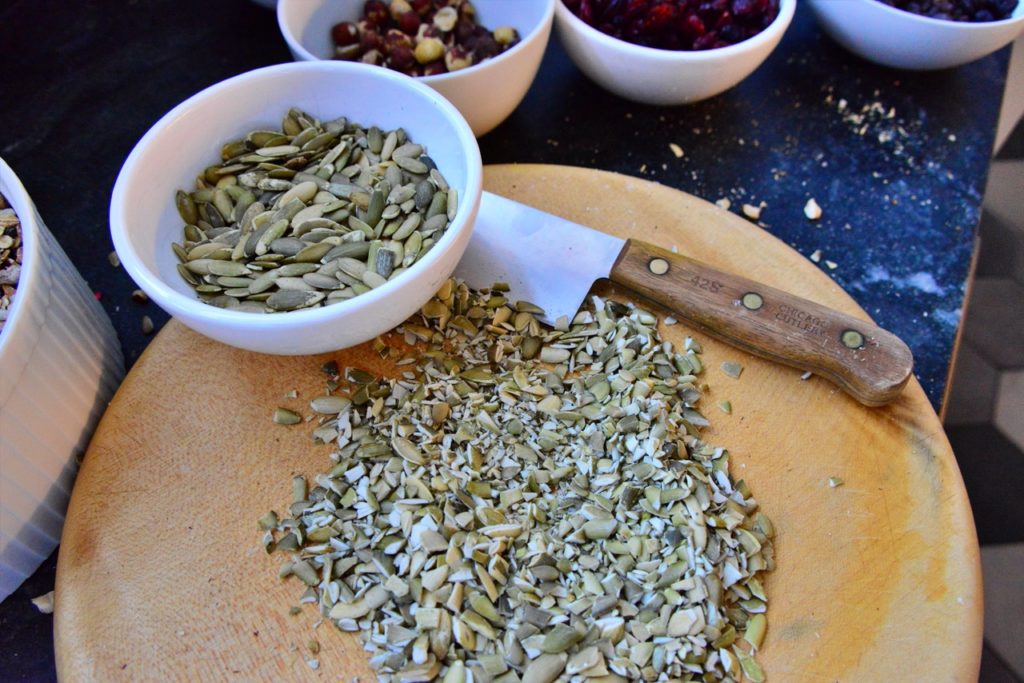
Pumpkin seeds are rich in minerals – and the best source of zinc and magnesium
A secret weapon against hair loss?
A straw in the wind is that pumpkin seed oil – again a much more concentrated form than a handful in your morning muesli – might help to reverse hair loss in men. This suggestion came in a study in which either testosterone or pumpkin seed oil was rubbed onto the skin of male mice. Applying testosterone to the skin clearly prevented the regrowth of hair, whereas the pumpkin seed oil increased hair growth by 10% after three weeks. Estrogen and testosterone appeared once again to be factors in the loss or growth of hair and the authors speculated that phytoestrogens (a plant-based molecule able to bind to estrogen receptors in the body) in pumpkin seed oil might have stimulated hair growth in male mice.
The mouse study (you’ll see the words “murine” or “murine model” in academic papers) followed one in men in which pumpkin seed oil achieved a 40% increase in mean hair count. The men had mild to moderate hair loss, a condition known as androgenetic alopecia present in around half of men over 50. The men drank 400mg of pumpkin seed oil every day for 24 weeks – a large amount – but the increased growth was statistically highly significant.
This kind of hair loss is thought to be partly the result of dihyrotestosterone (DHT) – an androgen that gives men their male characteristics – produced from testosterone by the enzyme 5-alpha reductase. DHT is thought to cause hair follicles to shrink, and to spend longer in their resting phase than the hair growth phase. It seems that by inhibiting 5-alpha reductase pumpkin seed oil reduces DHT, with these measurable effects on hair growth. But these are large doses of pumpkin seed oil, so don’t try this at home!
Sunflower seeds - the richest source of the antioxidant vitamin E
Sunflower seeds are another rich source of antioxidants, including selenium and especially vitamin E. The US Department of Agriculture describes sunflower seeds as the richest source of vitamin E. They also contain phytonutrient antioxidants such as phenolic acids and flavonoids.

Sunflower seeds mitigate the harmful effects of excess blood glucose
According to a review of scientific studies on sunflowers by they represent a “remarkable source of nutrients, minerals, antioxidants, and vitamins” and apart from countering oxidation and inflammation, reduce blood pressure and high blood sugar and promote the healing of wounds. Like the other nuts and seeds in our muesli they are high in healthy fats, protein and fiber.
Fats and proteins can be damaged by excess glucose in the blood, just as they can by free radicals (often in the form of ROS or NOS, radical oxygen – or nitrogen – species). Glucose attaches to these fats or proteins to “glycate” them, forming Advanced Glycation End Products, or AGEs. Sunflower seed – and this is especially the case if they are sprouted – can counter this extremely harmful effect of diabetes or prediabetes. The presence of radical species contributes to the formation of AGEs, so that the antioxidants in sunflower seeds have a double effect.
Raisins – antioxidants made easy for the body to use
Raisins are high in sugar, and accordingly calorific, but compared with the empty calories of sugar they are an excellent source of sweetening for food because they come loaded with other good things, including antioxidant phytonutrients and soluble fibre.
But first the sugar content. A study compared intake of raisin snacks and other more conventional snacks 3 times a day over a 12 week period. It found that the participants who ate the raisins had significantly reduced glucose levels than those who ate non-raisin snacks, and that their levels of glycated hemoglobin (the oxygen- carrying hemoglobin in red blood cells but with damaging glucose molecules attached to them) were also significantly lower. Another statistically significant finding was a reduction in blood pressure among the raisin group.
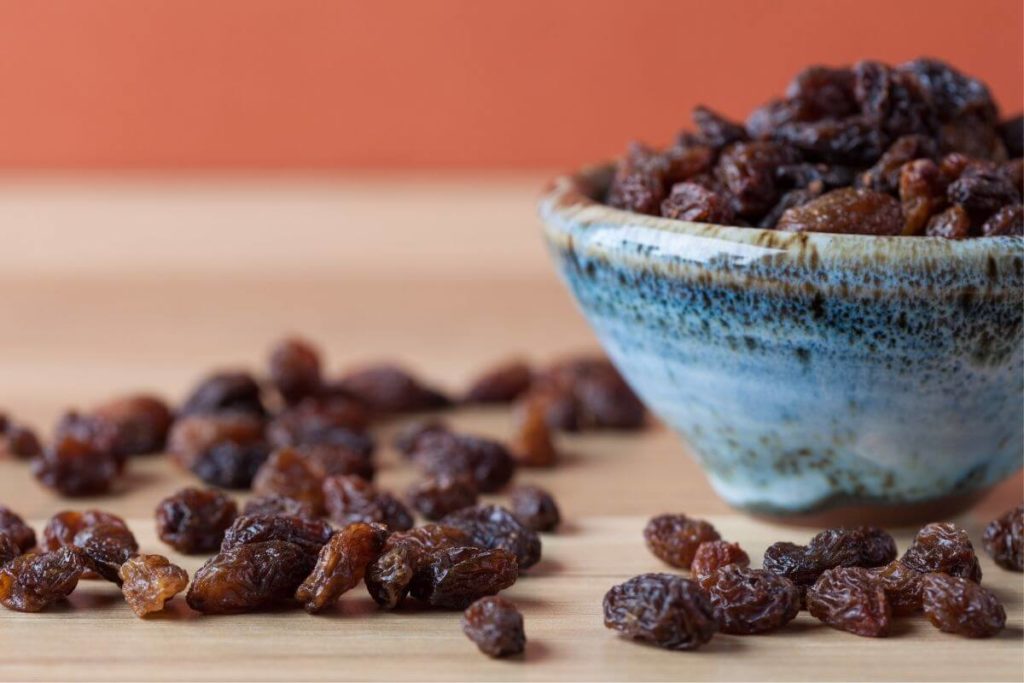
Raisins provide sweetness for muesli, but contain far more than empty sugar
Raisins and the power of antioxidants
The antioxidant phytonutrients in raisins include phenols and polyphenols. A review of studies on raisins shows that not only are antioxidants present in raisins at very high levels compared to other dried fruit (and drying preserves many antioxidants) but they are provided in such a way that the body can easily absorb them, a concept known as bioavailability. In a similar way, for example, the important carotenoids lutein and zeaxanthin are twice or three times more easily absorbed – available to the body – than they are taken directly from plant sources.
An alternative measure of the antioxidant capacity of food, Oxygen Radical Absorbance Capacity or ORAC, credits raisins with a high score. Expressing its values according to 100g of the food in question, ORAC places a value of 3,400 on raisins. The whole five-a-day of fruit and vegetables recommended as a minimum intake by many governments amounts to around 3,500 ORAC units. (See article “Oxidation Is Aging Us And Causing Disease. Antioxidants In Foods Can Neutralize The Free Radicals Causing It”.)
Cranberries – multiple studies suggest they increase beneficial HDL cholesterol
Cranberries’ high ORAC antioxidant score (9,584 per 100g), is the result of their rich stock of phytonutrients, including anthocyanins, flavonols and the proanthocyanins for which cranberries are famous.
Reasearch suggests that that constituents of cranberries could reduce the risks of cardiovascular disease. A review of studies into the effect of supplementing cranberries in the diet found they were associated with a significant reduction in weight (BMI), and in blood pressure, the latter especially among people over 50. Among participants under 50, there was a significant increase in the beneficial cholesterol HDL.
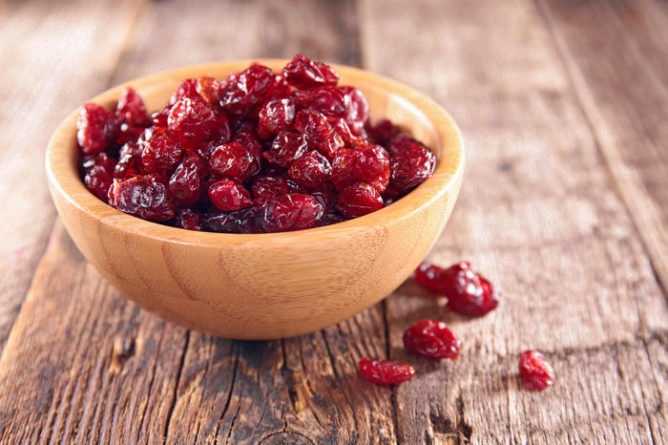
Cranberries’ antioxidants replenish the vital enzyme glutathione peroxidase
The same beneficial effect has been found on HDL in overweight and obese people. A study showed that eight weeks on a supplement of almost half a liter of cranberry extract drink reduced the amount of insulin in the blood (indicating a reduction in insulin resistance) and increased HDL. The effect of the polyphenols in the cranberries was suggested by an improvement in the antioxidant content of the blood, with an increase in the proportion of glutathione that had been replenished with electrons able to quench free radicals compared to the proportion that had already donated them and was therefore in an oxidized state.
A remarkable study from 2016 found that cranberries or nutrients derived from them have at least some effect in inhibiting 17 separate cancers, including common cancers of the colon and prostate. The study suggests that cranberries work by encouraging the death of malignant cells, inhibiting their proliferation, and modifying the harmful inflammatory response that can come with cancer.
A secret weapon in the battle against tooth decay
It’s been shown that one of the antioxidant constituents of cranberries – albeit in higher concentration than our muesli – can prevent one of the bacteria responsible for tooth decay from sticking to teeth. Streptococcus mutans is one leading culprit in tooth decay that forms slimy “biofilms” that we know as dental plaque. Biofilms generally allow bacterial colonies to attach to this sticky material – to increase adhesion to surfaces and enhance survival.
Inside their protective capsule or biofilm, Streptococcus mutans feed on the sugar sucrose producing lactic acid which attacks the teeth. Proanthocyanidins in cranberry extract were found to inhibit the formation of biofilms and the functioning of enzymes used by the S. mutans, and to reduce tooth decay.
Bacteria in the mouth, as in the gut, on the skin, and elsewhere, are a fact of human life, and by far the majority are “commensal”, evolving and now living with us harmlessly. There are tens of millions of bacteria in every milliliter of saliva, including more than 600 different species. They can transfer from person to person too, with the result that dental caries (tooth decay) is regarded an infectious disease.
It’s not only in the mouth that phytonutrients in cranberries prevent “sticking” by pathogenic bacteria. Cranberry juice is commonly suggested as a way of preventing urinary tract infections, because of its ability to prevent bacteria from attaching to the smooth cells lining the bladder and urethra.
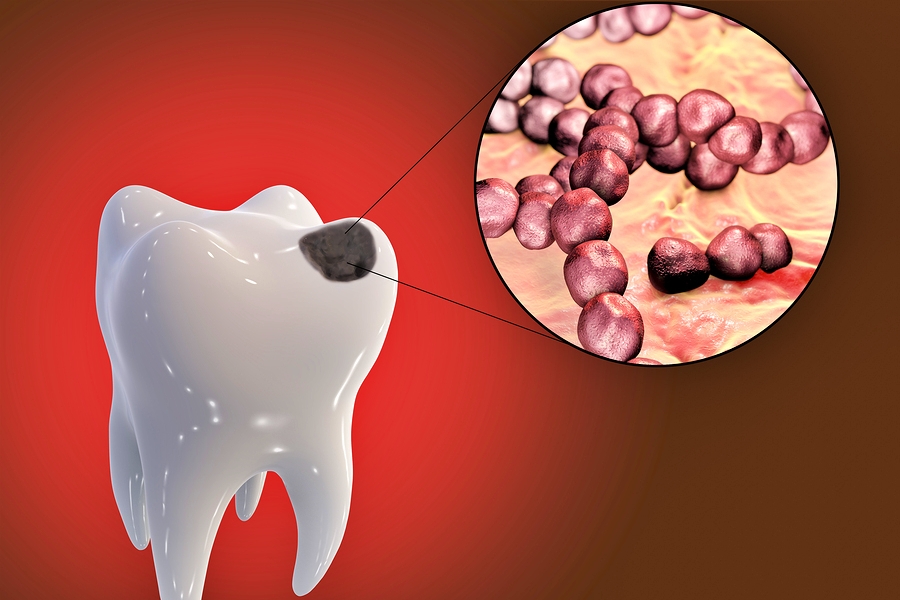
Even if you can’t see them, there are billions of bacteria in the mouth
A word about supplementation
The volume of nuts, seeds and fruit in our enhanced muesli is relatively small, usually far lower than the doses given to establish their effects on the body in scientific studies. However, they are clearly highly biologically active, and it’s their collective effect on the body that’s important.
Their inclusion in the muesli isn’t a recommendation for increasing intake by large amounts, although you might choose to eat more of any of the ingredients – perhaps by drinking unsweetened cranberry juice or by eating at least one more Brazil nut a day – in order to maximize a particular benefit suggested by scientific research.
But the evident benefits of nuts and seeds in the diet is not a reason for taking supplements which distil, or claim to distil, their most potent ingredients. An adequate amount can be important, more might be beneficial, but excess can be harmful – especially if you have what we’ve learnt to call “pre-existing conditions”.
Just to take cranberries as an example, if you’re on certain medicines to guard against blood clots, stroke and heart attack, sudden large increase in the amount you eat could be harmful. Drugs such as warfarin (trade names Coumadin and Jantoven) thin the blood and it’s possible that a large extra dose of cranberries could lead to bleeding.
Similarly, because cranberries contain a lot of oxalate, a compound found in many foods and excreted from the kidneys as a waste product. Oxalate is an important constituent of one type of kidney stones, and one study found an average increase of 43% in the amount of oxalate in urine in participants taking cranberry tablets (again, a much higher dose than in our muesli).
The healthy fats, ample protein, and almost absent sugar in our muesli ingredients

Key:
Kcal – calories, Sat Fat – saturated fat, PUFA – polyunsaturated fat, the vast majority omega 6, MUFA – monounsaturated fat, Vit E – vitamin E, Ca – calcium, Fe – iron, K+ – potassium, Cu – copper, Mn – manganese, Mg – magnesium, Zn – zinc, Se – selenium.
There are two extra ingredients to add at the point of eating the muesli – chia seed because if mixed in initially they will sink out of sight to the bottom of containers, and flaxseed, because they need to be ground, and as freshly ground as possible.
Flaxseed –estrogenic lignans might work against cancer
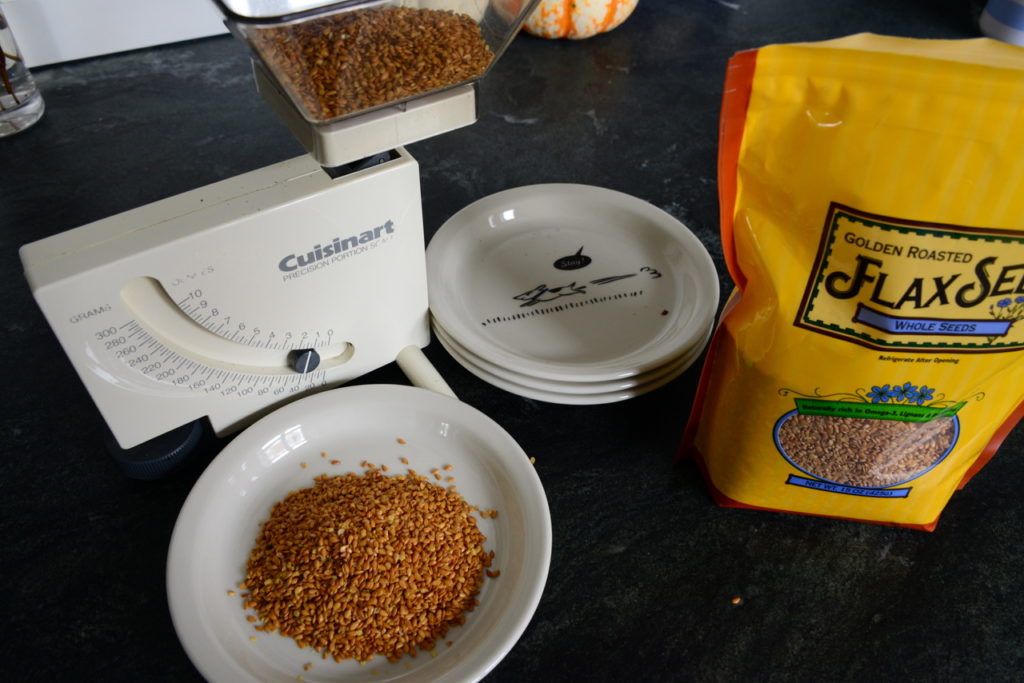
Studies suggest they are a potent reducer of blood pressure
Toasted flaxseed is perhaps the most potent of the secret health-promoting weapons in the armory of HealthSpan muesli. As well as being delicious – more about that in a moment – it is full of protein, healthy fats and fiber. Flaxseed (along with sesame seed) is the richest food source of another magic ingredient – dietary lignans.
Lignans are polyphenols with antioxidant and estrogenic effects. For their effect they rely on gut bacteria to convert these plant lignans into their mammalian counterparts enterodiol and enterolactone. The critical role of bacteria in metabolizing plant lignans – from flax seeds and attached to the fiber of other plants – means that the ability to do so varies between individuals and that antibiotic treatment can have a lasting impact on the ability to do so. This is another reason to nurture your microbiome, and to avoid unnecessary exposure to broad impact antibiotics.
Enterolactone exerts a weakly inhibitory effect on aromatase, an enzyme that takes part in estrogen synthesis that is overexpressed in breast cancer. Further evidence for a potential role for enterolactone in preventing breast cancer is levels are lower in breast cancer patients than other women. A review of the academic literature on the nutritional impact of flaxseeds suggests that lignans from flaxseed might act against precancerous changes in cells, and later by reducing the growth of blood vessels supplying tumors and inhibiting the spread of malignancy. Soya beans, and food such a tofu produced from them, also contain estrogenic polyphenols.
There’s evidence that lignans are also protective against cardiovascular disease. A review of studies in which flaxseed supplements were given to participants found that inflammation was reduced, as were levels of total cholesterol, and the potentially harmful LDL cholesterol.
For people who already have cardiovascular disease there’s strong evidence that flaxseed supplementation can reduce the hypertension that is an important risk factor and often accompanies the disease. The systolic blood pressure of patients who ate 30g of ground flaxseed a day for 6 months was reduced by 10mm Hg. Their diastolic pressure was reduced by 7mm Hg. Remarkably, readings for patients who already had more serious hypertension (of at least 140mm Hg, systolic) were 15mm Hg lower for systolic pressure and 7mm Hg for diastolic pressure.
The lower readings were correlated with patients’ blood levels of the plant-based omega 3 oil alpha-linolenic acid, in which flaxseed is particularly rich. The reduction in diastolic pressure was correlated with the amount of lignans in the blood of patients. The study concluded that flaxseed produced “one of the most potent antihypertensive effects” of any dietary supplement.
Another study found that the same flaxseed dose – 30g a day – reduced blood pressure in 50 patients with high cholesterol and other blood fats. After three months on the roasted flaxseed powder, patients had a “highly significant” reduction in triglycerides (fat in the blood that increases the risk of cardiovascular disease) and in total, LDL and VLDL (very low-density lipoprotein) cholesterol. The beneficial HDL was significantly improved.
Protect your flaxseed from light and air
A word about ground flaxseeds. If you eat the seeds as they are, protected inside their tough shells, most of them will pass from top to bottom of your alimentary canal more or less unmolested! But grinding up any nut or seed as rich in omega 3 fats as flaxseeds are (almost half their fat content is ALA or alpha-linolenic acid) will expose fat molecules that are particularly susceptible to oxidation to the air. Oxidised flaxseeds acquire a paint like or linseed oil like smell, and far from being good for you could be harmful.
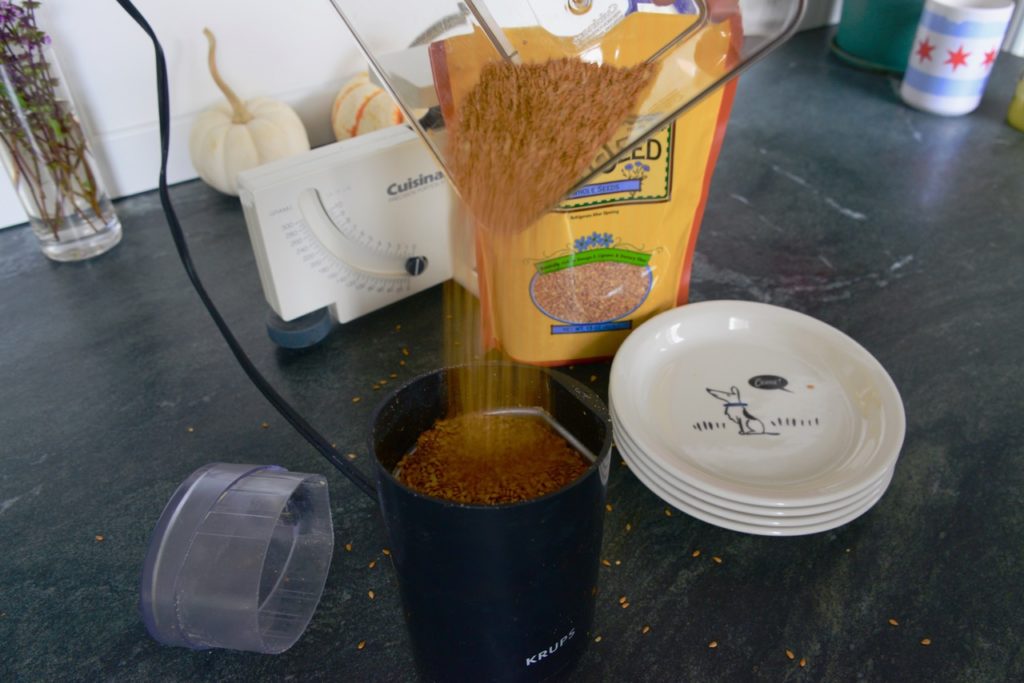
Ground flaxseed is highly susceptible to oxidation, so should be kept sealed in the refrigerator
It’s best therefore to grind up the seeds – I use a Krups coffee grinder – as and when you need them, or, if you grind up a whole package of flaxseed put them immediately back into the resealable plastic package, squeeze the air out and keep them in the refrigerator, using them within the next few days. It’s worth sniffing packages of flaxseed when you open them in case you smell the rancid paint odor rather than the nutty smell of the fresh seeds. If you do, take them back to the shop and complain, because rancid omega 3 oils – in fact any rancid oil – are actively damaging to health.
Which flaxseed?
There are plenty of sources of whole flaxseed for you to grind. I would recommend grinding your own so you can control the degree to which their fragile plant-based omega 3 polyunsaturated oils are exposed to the air and light.
There’s usually lots of choice for any of our ingredients, but not so much for toasted flaxseed. For a full, nutty taste I have not found anything to match Trader Joe’s Toasted Flaxseed (and no, I’m not getting any reward from Joe for saying so!). If you’re nowhere near a trading post, you can get it online.
SOME people MIGHT at first detect an extra – it’s been described as mildly fishy – taste, but please ignore it. This toasted flaxseed is delicious, the perfect augmentation for muesli quite apart from its hugely valuable nutritional content and fiber.
Chia Seed – 40% fiber, food for your bacteria, medicine for your gut
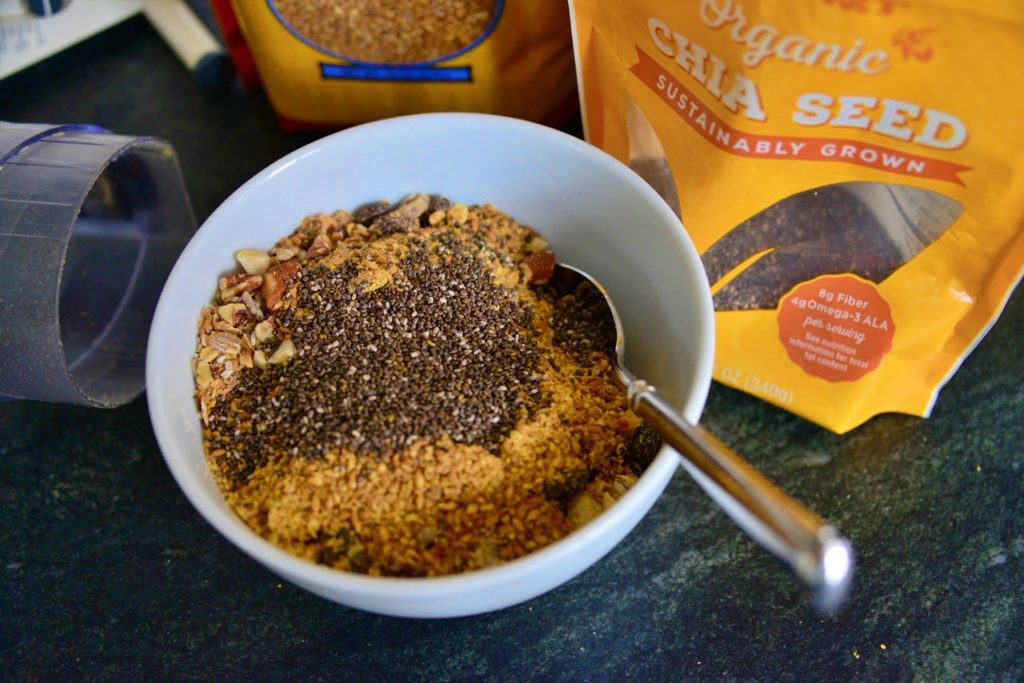
Chia seeds contain more concentrated plant-based omega 3 than any other food
Chia seed is another source of concentrated nutrition with the highest levels of the plant-based omega 3, alpha-linolenic acid of any plant (about 60% of its fat content). It’s also rich in protein, which makes up almost a fifth of its weight. Chia seeds are one of the small group of plants whose protein content includes all nine essential amino acids, although too little lysine for children to rely on them as a complete protein source.
Another outstanding characteristic of chia seed is its fiber, a full 40% of the seeds by weight. One ounce (about 28g) of chia seeds contains 12g of carbohydrates, but of those an astonishing 11g consist of fiber. It’s mostly soluble fiber, and gives chia seed the ability to absorb more than ten times their weight in water.
Soluble fiber works by combining with water in the gut to produce a kind of gel, one which can hold on to fat and sugar, slowing their passage through the wall of the gut into the blood, draw water into the gut reducing constipation and exercising intestinal muscles, and, most important of all, feeding gut bacteria. The fact that only our gut bacteria can digest these carbohydrates means that chia seed contain very few calories in comparison to their concentration of nutrients.
Simply adding water to chia seed – as we have in the pictures below – will quickly demonstrate how quickly and how much water they soak up to produce this beneficial soluble gel.
1 30g of chia seed

2 Add water

3 After 25 minutes the water is absorbed
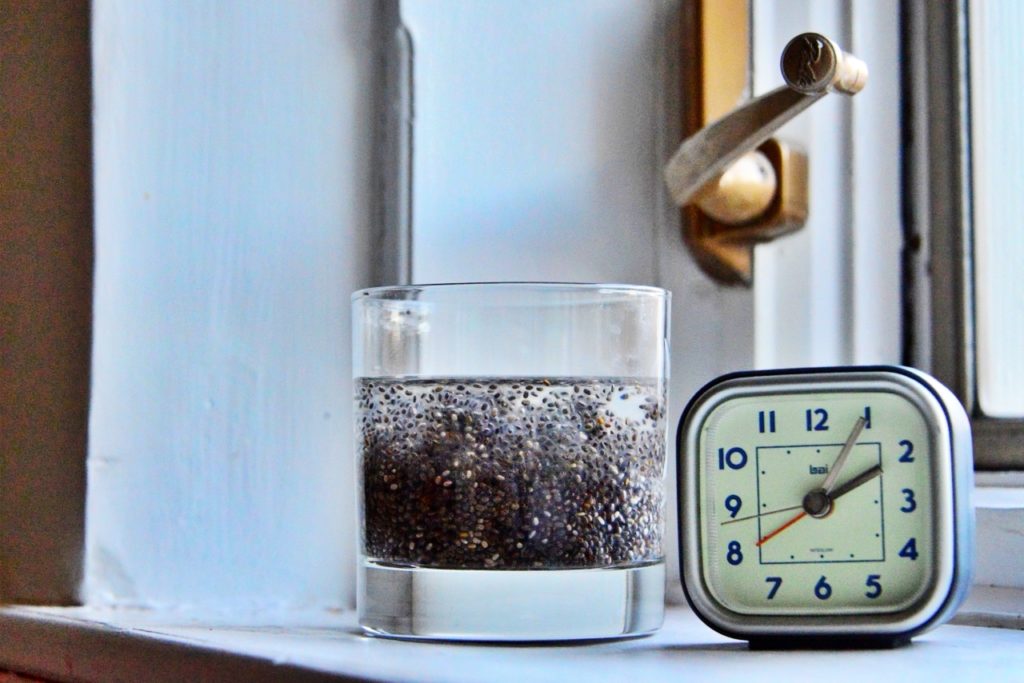
4 Add more water
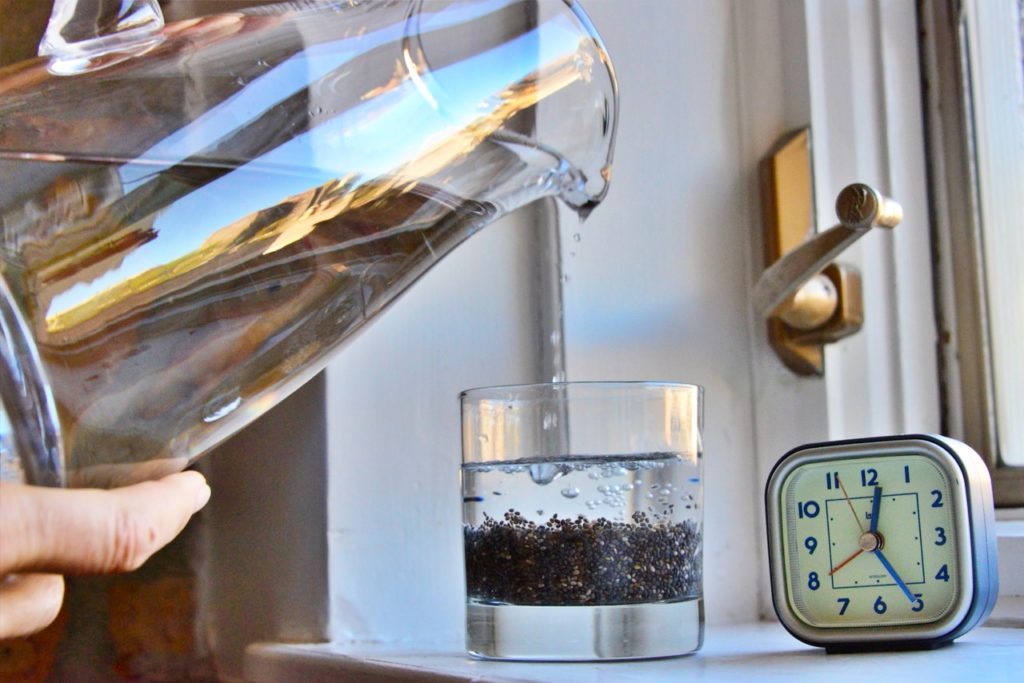
5 After 2 1/2 hours, the seed has expanded to a gel several times its original volume.
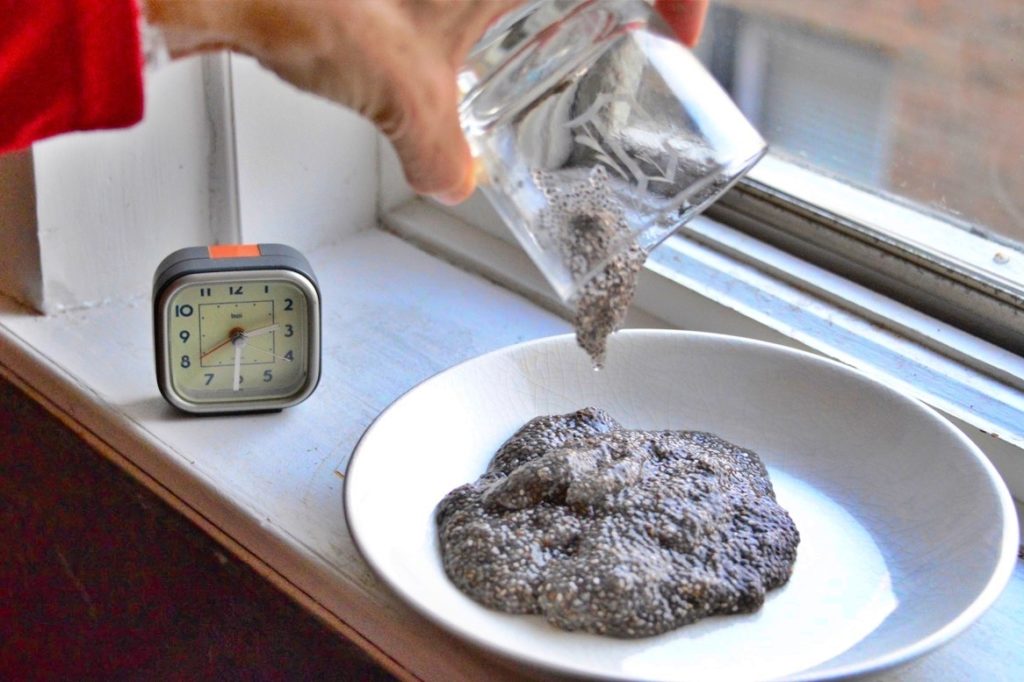
6 This soluble fiber reduces cholesterol, modifies glucose absorption and feeds beneficial bacteria.
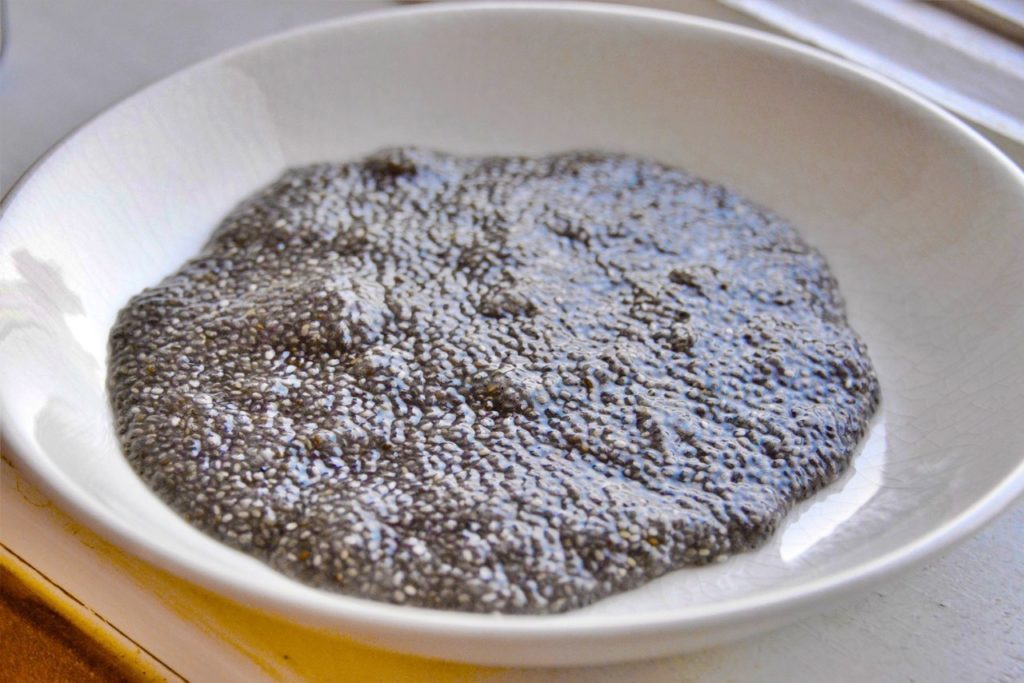
Comments are closed.